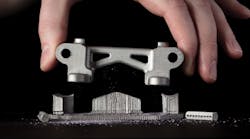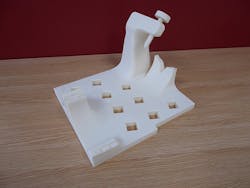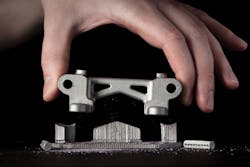With additive manufacturing (AM) on the rise and, in turn, disrupting markets of all types, it can be hard to keep up with everything. Nonetheless, the AM industry isn’t sitting idly by, as it continues to work on developing standards to keep pace with the new materials and machines that seem to be launching every week.
Standards
Just this month (Jan. 2018), the American Society of Mechanical Engineers (ASME) responded to the growing use of AM and 3D printing in global industries by developing a standard that covers definitions of terms and features unique to 3D printing. It applies to parts and assemblies designed in AM environments.
Titled Y14.46- 2017 Product Definition for Additive Manufacturing, it serves as an extension of the ASME Y14, which for years has provided engineers with the fundamental language for drafting and designing products and systems. The new Y14.46-2017 leverages model-based product definitions for additive manufacturing. It covers definitions of terms and features unique to AM technologies, with recommendations for their uniform specification in product definition data sets and in related documents. The ASME site highlights three key features:
- Theoretical supplemental surface: Identifying supplemental geometry within the model to assist metrology.
- Definition of 3D geometry not only for the end item, but also for process control, such as how to identify support structure.
- Data package bundling that incorporates the large amount of design requirements, in-process manufacturing, and quality measurement data.
As AM moves from a prototyping to an end-user process, it is important that the industry have clear communication. AM will see continued use for its ability to reduce material costs, offer greater manufacturing flexibility, and shorter lead times.
How 3D Printing Saves Money
The automotive industry has used 3D printers for tooling, fixtures, and gauges. This is possible with lower-cost plastic extrusion machines that some might think are nothing more than a hobbyist tool. However, the lines between low-cost printers and industrial tools are becoming blurred. Recently, using tooling and fixtures to cut cost started leaking into the aerospace industry.
Moog Aircraft Group has found that fused deposition modeling (FDM) saved time and money when making custom tooling and fixtures used in production. “The outsourcing process always had a lead time of four to six weeks from drawing release to receipt of a finished fixture,” says James Stuart-Young, Manufacturing Engineering Manager of the Military Value stream at Moog. “Fixtures that have cost us in excess of £2,000 in the past can now be made for a couple of hundred pounds.”
Moog Aircraft Group made this coordinate measurement machine fixture using a Stratasys Fortus 380 3D printer supplied by SYS Systems.
Just last year, Moog created an Additive Manufacturing Center (AMC) at its headquarters in East Aurora, N.Y., that works with titanium, Inconel, aluminum, copper, cobalt chrome, and stainless steel. For space applications, the most common materials used by Moog are aluminum, stainless, and titanium. The company plans on growing the AMC to be a turnkey center with all necessary pre- and post-processing capabilities needed to continue technology development. And, as developments emerge from the center, it will only increase the need for standards and testing programs in the AM industry.
Powder Metallurgy in AM
Standards are more than the machines and the process. On January 22, ASTM International announced its first proficiency testing program in additive manufacturing. Proficiency testing programs allow labs to compare their performance with others, ultimately helping all participants improve their performance.
The additive-manufacturing powder-metallurgy proficiency testing program (AMPM) will help labs measure physical properties of powders used in 3D printing. AMPM is built on the globally recognized standards and test methods developed in recent years by ASTM International and its committee on additive-manufacturing technologies. Check out this video:
Improving or having standard measurement techniques for powder metals could help promote the use of these materials. Last year saw a dramatic reduction in the cost of 3D-printing metal, and time-to-print. As a result, the use of powder metal could experience an upswing, making it ever-more important to have proper test-and-measurement practices.
The new Desktop Metal metal 3D printer uses powder metallurgy to print quickly, and sinter parts in one step. In one example, an impeller was printed using a laser-based printer and the new Desktop Metal printer. In the time it took the laser-based printer to produce 12 parts, Desktop Metal made over 500.
Testing laboratories and R&D facilities that participate will be given metal powders from manufacturers to measure and analyze density, flow rate, particle size, and other properties. The first cycle will be in April (register here), with another in October. For every new cycle, a new commercial sample will be sent.
The primary benefit of the program is having a statistical quality-assurance tool to monitor the strengths and weaknesses of lab performance in conducting testing. Many labs also use the program to help gain lab accreditation.
Increasing throughput and streamlining production efficiencies will drive growth for printers and materials substantially. Having standards in place with lower printer prices, faster build speeds, and cheaper materials will all contribute to the increase in demand. Given these market trends, IDTechEx forecasts the global market for 3D printing metals will reach a value of $12 billion by the year 2028.
Hewlett-Packard has seen the potential market size for metal AM and invested heavily. Stephen Nigro, President of the company’s 3D Printing business unit, mentioned an aspiration to disrupt the $12 trillion manufacturing market. “Now, we are expanding beyond plastic to metals. But why now? Pretty much the same reason we got into 3D plastics with Multi Jet Fusion. …We have developed a novel 3D metal approach that is built around a combination of high quality and improving the economics of 3D-printed metals.”
Without going into details about the process, Nigro mentioned that HP is looking to bring about high-volume metal printing at an affordable rate in 2018.
With some standards starting to take hold and more on the way, 3D printing is digging deeper into different industries. As AM grows, and with new applications still to be found, companies continue to innovate to grab as much of this emerging market as they can.



